|
Planetary Facts &
Figures |
| |
|

Planet Symbol
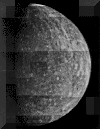
Planet Surface
 |
Mercury,
the planet closest to the Sun, has almost no atmosphere and its dusty
surface of craters resembles the Moon. The planet was named for the
Roman god Mercury, a winged messenger, because it travels through the sky
quickly. In fact, it travels around the Sun faster
than any other planet. Mercury is difficult to see from Earth because
of the glare from the sun. Nicolaus Copernicus, for all his
years of research and observation, never once was able to see Mercury.
|
 | Size: two-fifths the size
of Earth; second smallest in the solar system. |
 | Diameter: 3,032.4 miles
(4,880 km). |
 | Surface: covered by a
dusty layer of minerals (silicates), the surface is made up of plains,
cliffs, and craters. |
 | Atmosphere: a thin
mixture of helium (95%) and hydrogen. |
 | Temperature: Mercury
alternately bakes and freezes, depending on what side is lit by the Sun.
The sunlit side can reach up to 950° F (510° C) and the dark side can drop
as low as –346° F (–210° C). |
 | Rotation of its axis: 59
Earth days. |
 | Rotation around the Sun:
88 Earth days. |
 | Your weight: if you weigh
100 pounds on Earth, you would weigh 38 pounds on Mercury. |
 | Distance from Earth: 57
million miles, at the closest point in its orbit. |
 | Mean Distance from Sun:
36 million miles (57.9 million km). |
 | Satellites: 0
|
 | Rings: 0 |
|
| |
|

Planet Symbol
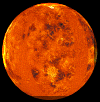
Global View

Volcanoes |
Venus is
often called Earth's twin because the two planets are close in size but
that's the only similarity. The thick clouds that cover Venus create a
greenhouse effect that keeps it sizzling at 864°F. Venus, named after
the Roman goddess of love and beauty, is also known as the “morning star”
and “evening star” since it is visible at these times to the unaided eye.
Venus appears as a bright, white disk from Earth. |
 | Size: about 650 miles
smaller in diameter than Earth. |
 | Diameter: 7,519 miles
(12,100 km). |
 | Surface: a rocky, dusty,
waterless expanse of mountains, canyons, and plains, with a 200-mile river
of hardened lava. |
 | Atmosphere: carbon
dioxide (95%), nitrogen, sulfuric acid, and traces of other elements.
|
 | Temperature: ranges from
55°F (13°C) to 396°F (202°C) at the surface. |
 | Rotation of its axis: 243
Earth days. |
 | Rotation around the Sun:
225 Earth days. |
 | Your weight: if you weigh
100 pounds on Earth, you would weigh 88 pounds on Venus. |
 | Distance from Earth: at
its closest, Venus is 26 million miles (41,840,000 km) away. |
 | Mean Distance from Sun:
67.24 million miles (108.2 million km). |
 | Satellites: 0
|
 | Rings: 0 |
|
| |
|

Planet Symbol

Global View |
Earth is
not perfectly round as it bulges at the equator and is flatter at the poles.
From space the planet looks blue with white swirls, created by water and
clouds. Only planet known to have life. |
 | Size: four planets in our
solar system are larger and four are smaller than Earth. |
 | Diameter: 7,926.2 miles
(12,756 km). |
 | Surface: Earth is made up
of water (70%), air and solid ground. It appears to be the only
planet with water. |
 | Atmosphere: nitrogen
(78%), oxygen (21%), other gases. |
 | Rotation of its axis: 23
hours, 56 minutes, 4 seconds. |
 | Rotation around the Sun:
365.2 days. |
 | Mean Distance from Sun:
92.9 million miles (149.6 million km). |
 | Satellites: 1 |
 | Rings: 0 |
|
| |
|

Planet Symbol
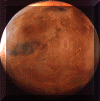
Global View

Largest volcano in
Solar System
|
Because
of its blood-red color (which comes from iron-rich dust), this planet was
named for Mars, the Roman god of war. Mars is the fourth planet from
the Sun, situated between Earth and Jupiter. Three-quarters red, Mars
also has dark blotches on it and white areas at the poles (which are
polar ice caps made of frozen water/carbon dioxide.) |
 | Size: about one-quarter
the size of Earth. |
 | Diameter: 4,194 miles
(6,794 km). |
 | Surface: canyons, dunes,
volcanoes and polar caps of water ice and carbon dioxide ice. |
 | Atmosphere: carbon
dioxide (95%). |
 | Temperature: as low as
–305°F (–187°C). |
 | Rotation of its axis: 24
Earth hours, 37 minutes, 23 seconds. |
 | Rotation around the Sun:
687 Earth days. |
 | Your weight: if you weigh
100 pounds on Earth, you would weigh 38 pounds on Mars. |
 | Distance from Earth: 35
million miles (56 million km) at the closest point in its orbit.
|
 | Mean Distance from Sun:
141.71 million miles (227.9 million km). |
 | Satellites: 2
|
 | Rings: 0 |
|
| |
|

Gaspra
|
Asteroids
are small bodies that are believed to be left over from the beginning of the
solar system 4.6 billion years ago. They are rocky objects with round
or irregular shapes up to several hundred km across, but most are much
smaller. More than 100,000 asteroids lie in a belt between Mars and
Jupiter. These asteroids lie in a location in the solar system where
there seems to be a jump in the spacing between the planets.
Scientists believe the Asteroid Belt is either an unformed
planet or a planet that was broken apart due to the gravity of Jupiter or by
a large impact. |
| |
|

Planet Symbol
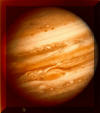
Jupiter & Ganymede

Io, in eclipse |
Jupiter,
the largest planet in our solar system, was named for the most important
Roman god because of its size. About 1,300 Earths would fit into the
planet.
Viewed through a large telescope, Jupiter is stunningly colorful—it is a
disk covered with bands of blue, brown, pink, red, orange and yellow.
Its most distinguishing feature is “the Great Red Spot,” an intense
windstorm larger in size than the Earth, which has continued for centuries
without any signs of dying down. |
 | Size: 11 times the
diameter of Earth. |
 | Diameter: 88,736 miles
(142,800 km). |
 | Surface: a hot ball of
gas and liquid. |
 | Atmosphere: whirling
clouds of colored dust, hydrogen, helium, methane, water and ammonia. The
Great Red Spot is an intense windstorm larger than Earth. There is
evidence that the Great Red Spot is getting smaller. |
 | Temperature: –234°F
(–148°C) average. |
 | Rotation of its axis: 9
hours and 55 minutes. |
 | Rotation around the Sun:
12 Earth years. |
 | Your weight: if you weigh
100 pounds on Earth, you would weigh 265 pounds on Jupiter. |
 | Distance from Earth: at
its closest, 370 million miles (591 million km). |
 | Mean Distance from Sun:
483.88 million miles (778.3 million km). |
 | Satellites: 63 (as of
November 2007) |
 | Rings: Yes (4) |
|
| |
|

Planet Symbol

Cassini spacecraft
during flyby of Saturn |
Saturn,
the second-largest planet, has majestic rings surrounding the planet. Named
for the Roman god of farming, Saturn was the farthest planet known by the
ancients. Saturn's rings are flat and lie inside one another. They are
made of billions of ice particles and rock. Saturn is of such low
density that if you could place the planet in a bathtub, (imagine the
size!), it would float! |
 | Size: about 10 times
larger than Earth. |
 | Diameter: 74,978 miles
(120,660 km). |
 | Surface: liquid and gas.
|
 | Atmosphere: hydrogen and
helium. |
 | Temperature: –288°F
(–178°C). |
 | Rotation of its axis: 10
hours, 40 min, 24 sec. |
 | Rotation around the Sun:
29.5 Earth years. |
 | Your weight: if you weigh
100 pounds on Earth, you would weigh 107 pounds on Saturn. |
 | Distance from Earth: 744
million miles at the closest point. |
 | Mean Distance from Sun:
887.14 million miles (1,427 million km). |
 | Satellites: 60 (as of
November 2007) |
 | Rings: 1,000+ |
|
| |
|

Planetary Symbol
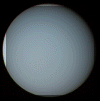
Global View |
Uranus is a greenish-blue planet,
twice as far from the Sun as its neighbor Saturn. Uranus wasn't
discovered until 1781. It's discoverer, William Herschel, named it
Georgium Sidus (the Georgian star) after the English king, George III.
Later its name was changed to Uranus, after an ancient Greek sky god, since
all the other planets had been named after Roman and Greek gods.
|
 | Size: 4 times larger than
Earth. |
 | Diameter: 32,193 miles
(51,810 km). |
 | Surface: little is known.
|
 | Atmosphere: hydrogen,
helium, and methane. |
 | Temperature: uniform
temperature of –353°F (–214°C). |
 | Rotation of its axis: 17
hours. |
 | Rotation around the Sun:
30,685 days or 84 Earth years. |
 | Your weight: not known.
|
 | Distance from Earth: at
the closest point 1,607,000 miles. |
 | Mean Distance from Sun:
1,783.98 million miles (2,870 million km). |
 | Satellites: 27 (as of
November 2007) |
 | Rings: 11 |
|
| |
|

Planet Symbol
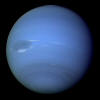
Global View showing
"Great Blue Spot." This spot has disappeared and reappeared
indicating that storms form and dissipate similar to weather systems on
Earth. |
Neptune, named for an ancient Roman
sea god, is a stormy blue planet about 30 times farther from the Sun than
Earth. Neptune was discovered when astronomers realized that something
was exerting a gravitational pull on Uranus and that it was possible that an
unknown planet might be responsible. Through mathematical
calculations, astronomers determined there was indeed an undiscovered planet
out in space—a year before it was actually seen for the first time through a
telescope (in 1846). |
 | Size: about 4 times the
size of Earth. |
 | Diameter: 30,775 miles
(49,528 km). |
 | Surface: a liquid layer
covered with thick clouds and with constant, raging storms. |
 | Atmosphere: hydrogen,
helium, methane and ammonia. |
 | Temperature: –353°F
(–214°C). |
 | Rotation of its axis: 16
hours and 7 minutes. |
 | Rotation around the Sun:
165 Earth years. |
 | Your weight: not known.
|
 | Distance from Earth:
2,680,000,000 miles at closest point. |
 | Mean Distance from Sun:
2,796.46 million miles (4,497 million km). |
 | Satellites: 13 (as of
November 2007) |
 | Rings: 4 |
|
| |
|

Planet Symbol

Pluto & Charon

Pluto & Charon as
seen by the Hubble telescope |
Pluto, named after the Roman and Greek
god of the underworld, is the coldest, smallest and outermost body in our
solar system. Pluto has been demoted as a full planet and is now
referred to as a "plutonian" or "dwarf planet." Pluto and its moon, Charon, are called "double planets"
because Charon is so large it seems less of a moon than another planet.
Pluto was predicted to exist in 1905 and discovered in 1930. It is the
only solar system body that has not yet been studied closely by a space probe.
This will change with the New Horizons Mission which will reach Pluto in
July of 2015.
During each revolution around the sun, Pluto passes inside Neptune's orbit
for 20 years, making Neptune the outermost planet for that time. Pluto
passed inside Neptune's orbit in 1979 and remained there until 1999.
It will not return to that position until 2227. |
 | Size: less than one-fifth
the size of Earth. |
 | Diameter: 1,423 miles?
(2,290 km?). |
 | Surface: a giant snowball
of methane and water mixed with rock. |
 | Atmosphere: methane.
|
 | Temperature: between -
369°F and - 387°F (- 223°C and - 233°C). |
 | Rotation of its axis: 6
days, 9 hours, 18 minutes. |
 | Rotation around the Sun:
248 Earth years. |
 | Your weight: not known.
|
 | Distance from Earth: at
the closest point, 2.67 billion miles. |
 | Mean Distance from Sun:
3,666 million miles (5,900 million km). |
 | Satellites: 3 (as of
November 2007) |
 | Rings: ? |
|
























